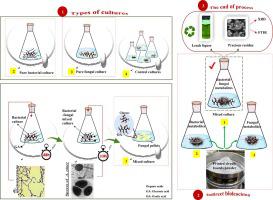当前位置:
X-MOL 学术
›
Waste Manag.
›
论文详情
Our official English website, www.x-mol.net, welcomes your feedback! (Note: you will need to create a separate account there.)
Exploring the untapped practices in bacterial-fungal mixed-based cultures for acidic treatment of metal-enriched printed circuit board waste
Waste Management ( IF 8.1 ) Pub Date : 2024-03-16 , DOI: 10.1016/j.wasman.2024.02.030 Farzane Vakilchap , Seyyed Mohammad Mousavi
Waste Management ( IF 8.1 ) Pub Date : 2024-03-16 , DOI: 10.1016/j.wasman.2024.02.030 Farzane Vakilchap , Seyyed Mohammad Mousavi

|
This study explores the extraction of metals from spent mobile phone printed circuit boards (SMPhPCBs) to address environmental and resource depletion concerns. The challenges in metal recovery from SMPhPCBs arise due to their complex composition and high metal content. While previous research has primarily focused on using bio-cyanide, bio-sulfate, and bio-ferric compounds from acidophilic bacteria, the potential of bio-oxalic acid for SMPhPCBs treatment and the alteration of their complex structure has not yet been explored. Additionally, this study suggests evaluating the untapped potential of in oxalic acid production through mixed cultures with bacteria, marking a pioneering approach. A unique culture of and was created, inducing bio-stress by bacterial metabolites, including gluconic acid (2683 mg/l) and live/dead bacterial cells in a medium with glucose deficiency. Results demonstrated reducing sugar consumption and oxalic acid over-production in mixed cultures compared to pure cultures, ranging from 1350 to 4951 mg/l at an initial glucose concentration (IGC) of 10 g/l and 4276 to 7460 mg/l at IGC 20 g/l. This over-production is attributed to proposed fungal signaling mechanisms to bacteria. Metal extraction using organic acids and siderophores at 10 g/l pulp density, 24 h, and 60 °C yielded Mn (100 %), Pt (100 %), Pd (70.7 %), Fe (50.8 %), Co (48.3 %), Al (21.8 %), among others. The final valuable residue containing copper, gold, and silver holds potential for future recycling. The study concludes with XRD and FTIR analyses to assess the bioleaching effect on the bio-leached powder.
中文翻译:

探索细菌-真菌混合培养物对富金属印刷电路板废物进行酸性处理的未开发实践
本研究探索从废旧手机印刷电路板 (SMPhPCB) 中提取金属,以解决环境和资源枯竭问题。 SMPhPCB 的金属回收面临的挑战是由于其复杂的成分和高金属含量。虽然之前的研究主要集中在使用来自嗜酸细菌的生物氰化物、生物硫酸盐和生物铁化合物,但生物草酸用于 SMPhPCB 处理及其复杂结构改变的潜力尚未被探索。此外,这项研究建议通过与细菌混合培养来评估草酸生产中未开发的潜力,这标志着一种开创性的方法。创建了一种独特的培养物,通过细菌代谢物诱导生物应激,包括葡萄糖酸(2683 mg/l)和葡萄糖缺乏培养基中的活/死细菌细胞。结果表明,与纯培养物相比,混合培养物减少了糖消耗和草酸过量产生,初始葡萄糖浓度 (IGC) 为 10 g/l 时,糖消耗量为 1350 至 4951 mg/l,IGC 20 时为 4276 至 7460 mg/l克/升。这种过量生产归因于所提出的细菌的真菌信号传导机制。使用有机酸和铁载体在 10 g/l 矿浆密度、24 小时和 60 °C 下萃取金属,得到 Mn (100 %)、Pt (100 %)、Pd (70.7 %)、Fe (50.8 %)、Co (48.3) %)、铝 (21.8 %) 等。最终含有铜、金和银的有价值的残留物具有未来回收利用的潜力。该研究通过 XRD 和 FTIR 分析得出结论,以评估生物浸出粉末的生物浸出效果。
更新日期:2024-03-16
中文翻译:

探索细菌-真菌混合培养物对富金属印刷电路板废物进行酸性处理的未开发实践
本研究探索从废旧手机印刷电路板 (SMPhPCB) 中提取金属,以解决环境和资源枯竭问题。 SMPhPCB 的金属回收面临的挑战是由于其复杂的成分和高金属含量。虽然之前的研究主要集中在使用来自嗜酸细菌的生物氰化物、生物硫酸盐和生物铁化合物,但生物草酸用于 SMPhPCB 处理及其复杂结构改变的潜力尚未被探索。此外,这项研究建议通过与细菌混合培养来评估草酸生产中未开发的潜力,这标志着一种开创性的方法。创建了一种独特的培养物,通过细菌代谢物诱导生物应激,包括葡萄糖酸(2683 mg/l)和葡萄糖缺乏培养基中的活/死细菌细胞。结果表明,与纯培养物相比,混合培养物减少了糖消耗和草酸过量产生,初始葡萄糖浓度 (IGC) 为 10 g/l 时,糖消耗量为 1350 至 4951 mg/l,IGC 20 时为 4276 至 7460 mg/l克/升。这种过量生产归因于所提出的细菌的真菌信号传导机制。使用有机酸和铁载体在 10 g/l 矿浆密度、24 小时和 60 °C 下萃取金属,得到 Mn (100 %)、Pt (100 %)、Pd (70.7 %)、Fe (50.8 %)、Co (48.3) %)、铝 (21.8 %) 等。最终含有铜、金和银的有价值的残留物具有未来回收利用的潜力。该研究通过 XRD 和 FTIR 分析得出结论,以评估生物浸出粉末的生物浸出效果。



























 京公网安备 11010802027423号
京公网安备 11010802027423号